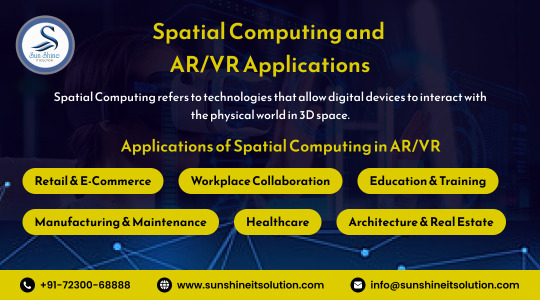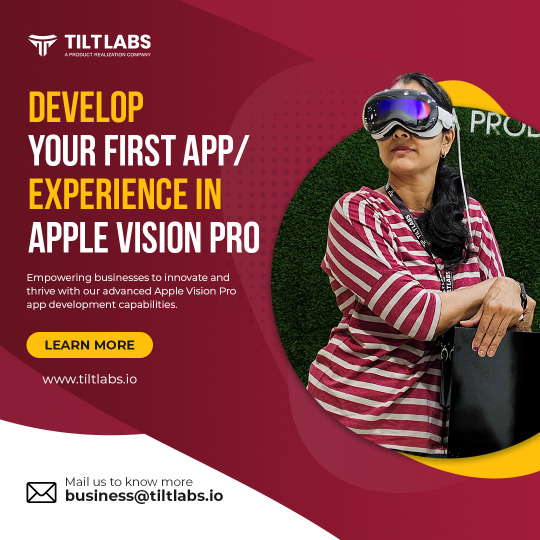#spatialcomputing
Explore tagged Tumblr posts
Text
The Metamorphosis of Geospatial Technologies: Mapping the Path to 2030
In the rapidly evolving digital landscape, geospatial technologies stand at the precipice of a profound transformation—one that promises to redefine our relationship with spatial data and revolutionize countless industries. As we navigate through 2025, emergent technological paradigms are already reshaping the foundations of this field, with the trajectory toward 2030 signaling a period of…

View On WordPress
#ai#artificial-intelligence#digitaltwins#education#geographicinformationsystems#geospatialinelligence#geospatialtech2030#GISfuture#maps#spatialcomputing#technology
2 notes
·
View notes
Text
#AugmentedReality#AI#SpatialComputing#5G#WebAR#ARTrends#TechFuture#MixedReality#DigitalTransformation#AR2025
0 notes
Link
#ARadoption#cross-regionalinnovation#decentralizedmarketplaces#metaverseinteroperability#mobile-firstsolutions#retaildigitization#spatialcomputing#Web3commerce
0 notes
Text

🌍✨ Spatial Computing & AR/VR Applications: Blurring the Line Between Real and Digital 🕶️🧠
The future isn't on a screen — it's all around us.
Welcome to the era of Spatial Computing, where Augmented Reality (AR) and Virtual Reality (VR) merge digital content seamlessly with our physical world. 🚀
🔹 Imagine training employees in a virtual factory before they ever step into one. 🔹 Visualizing architectural designs in your living room. 🔹 Interacting with digital products as if they were physically in your hands.
💡 It’s time to shift from observing technology to living it.
Please explore our YouTube channel for informative videos. Link :- https://www.youtube.com/@sunshineitsolutions
Visit our blog for informative business ideas https://www.blog.sunshiene.com/
Contact Us :- https://wa.me/+91-7230068888
WhatsApp Channel ( Subscribe for more updates ) https://whatsapp.com/channel/0029Vb0QMGg0bIdggODhE22T
#SpatialComputing#ARVR#AugmentedReality#VirtualReality#ImmersiveTech#DigitalInnovation#FutureIsNow#SunShineITSolution#TechTransformation
0 notes
Text
Top 10 Vision Pro Apps That Are Redefining Reality in 2025!
Apple’s Vision Pro isn’t just a device—it’s a whole new world. And these apps? They're leading the revolution.
From spatial productivity tools to immersive entertainment, here are the Vision Pro apps that are making headlines and shaping the future of mixed reality.
🔥 Whether you're a developer, product designer, or XR enthusiast—these apps will inspire your next big idea.
#VisionProApps#AppleVisionPro#SpatialComputing#XRTrends#MixedReality#FutureOfApps#TechInnovation#UIUXDesign#SpatialTech#VisionProDevelopment#ImmersiveTech#KodyTechnolab#ARVRApps#VisionOS#NextGenApps
0 notes
Text
Step into the future with custom AR/VR solutions.
From 3D modeling to system integration, SDH builds immersive, cross-platform experiences that blur the line between real and digital. 💡 Tailored. Scalable. Ready for what’s next.
0 notes
Photo

Every great innovation begins as an idea, but the future belongs to those who build it. Standing at 1 Hacker Way, I can’t help but admire how Meta dares to redefine human connection through XR and VR. One day, I hope to leave my imprint on the next frontier of digital reality in real estate ventures.
#futureoftech#xr#vr#metaverse#architectureandtech#aiinnovation#digitaltransformation#spatialcomputing#arvr#futurecities#nextgenarchitecture#designingthefuture#techvisionary#extendedreality#meta#innovation
0 notes
Text
5 Key UX/UI Principles for Designing Augmented Reality (AR) Applications
Introduction
Augmented Reality (AR) is changing how we interact with the digital world, seamlessly blending virtual elements with our surroundings. A well-designed AR application provides a smooth, intuitive experience that enhances usability and engagement. However, designing AR apps comes with unique challenges, such as real-world adaptation and spatial awareness. Whether you are working with an android game development company or creating enterprise AR solutions, focusing on UX/UI principles will ensure a better experience. Let’s explore five key guidelines that can help make AR applications more effective and user-friendly.
1. Seamless Integration with the Real World
For an AR experience to feel natural, virtual objects must merge effortlessly into the user's environment. If AR elements appear misplaced or unrealistic, it can disrupt the experience and make interactions awkward.
Best Practices:
Use real-world lighting and shadows to make AR objects blend naturally.
Apply object occlusion, ensuring AR objects behave realistically (e.g., an AR object placed behind a real object should be partially hidden).
Optimize spatial tracking to keep AR elements stable and responsive as users move.
Keep the interface uncluttered; too many digital elements can overwhelm users and reduce engagement.
A smooth, real-world integration makes AR more immersive and enjoyable.
2. Intuitive and Simple Interactions
A great AR application should feel natural and easy to use. Users should be able to interact with it effortlessly, without needing a steep learning curve. Since AR is different from traditional apps, designers should move beyond standard buttons and menus.
Best Practices:
Use familiar touch and gesture controls (tap, swipe, pinch) for natural interactions.
Provide real-time visual and haptic feedback to confirm actions.
Avoid complicated multi-step gestures that may frustrate users.
Offer guided onboarding experiences to help users understand features quickly.
If you're developing AR applications with an android game development company India, prioritizing ease of use will improve user engagement.
3. Minimalistic & Adaptive UI Design
Unlike traditional apps, AR applications need a UI that is lightweight and non-intrusive. Cluttered interfaces can distract users and take away from the immersive experience.
Best Practices:
Display only essential UI elements and use gestures or pop-ups for additional options.
Use semi-transparent overlays to avoid obstructing the real-world view.
Position UI elements where they are easily accessible without being intrusive.
Make UI elements adaptive, adjusting dynamically based on the user’s environment.
Collaborating with the best android game developer company ensures a clean, well-designed interface that enhances focus without being overwhelming.
4. Enhanced Spatial Awareness & Depth Perception
AR relies on accurate spatial positioning, which means users need to perceive depth and space correctly. Poorly defined depth perception can make objects appear unnatural or difficult to interact with.
Best Practices:
Use depth cues such as shading, object scaling, and motion effects to create realistic distances.
Ensure AR elements adjust dynamically based on user movement.
Allow users to manually move and resize AR objects for better control.
Layer objects properly so that they appear in a natural hierarchy within the scene.
Working with an android game development company USA can help fine-tune depth perception for a more immersive AR experience.
5. Accessibility & User Comfort
AR applications should be inclusive, ensuring they work for people with different abilities and preferences. A poorly designed AR experience can cause motion sickness, eye strain, or discomfort.
Best Practices:
Reduce fast or erratic movements to prevent dizziness.
Offer alternative controls such as voice commands for users with limited mobility.
Design UI elements with high contrast and clear text for better visibility in various lighting conditions.
Allow users to adjust settings, including brightness and interaction sensitivity, for personal comfort.
A user-first approach ensures that more people can enjoy AR applications, whether developed by an android game development company associative or a large-scale enterprise.
Conclusion
Designing AR applications is about creating seamless, natural, and enjoyable experiences that feel like an extension of the real world. Whether you’re working with an android game development company or a startup experimenting with AR, focusing on these UX/UI principles will ensure a smoother and more engaging user experience. By prioritizing real-world integration, intuitive usability, minimalistic UI, spatial awareness, and accessibility, designers can develop AR applications that truly enhance digital interactions.
A well-designed AR experience doesn’t just augment reality it transforms how we interact with the world.
#AugmentedReality#ARDesign#UXUI#ARDevelopment#UserExperience#UIDesign#AndroidGameDevelopment#ARApplications#ImmersiveTech#GameDevelopment#MobileUX#SpatialComputing#XRDesign#TechInnovation#HumanCenteredDesign#ARGaming
0 notes
Text
Apple Vision Pro
Last week, I had the chance to try out the Apple Vision Pro, and let me tell you—it is truly something else. No, scratch that. It’s more than great. It’s an experience that feels groundbreaking, almost indescribable. This is far more than just a simple VR headset; Apple has redefined the way we interact with technology, and I’m still wrapping my head around how incredible it truly is.
To paint a picture, using the Vision Pro reminded me of something oddly specific: taking off ski boots. There’s that moment when you return to walking normally and appreciate the simplicity of it, but at the same time, you can’t help but think back fondly on how exhilarating your time on the hill was. That’s exactly how the Vision Pro feels. You step back into reality, but your mind keeps replaying the immersive, mind-blowing moments you’ve just experienced, and all you want to do is dive right back in.
The level of detail and sophistication in this device is astounding. The visual clarity is so sharp and lifelike that it feels like stepping into another world not just viewing one. Apple’s decision to focus on spatial computing rather than simply virtual reality changes the game entirely. You’re not cut off from the real world; instead, it feels like the digital and physical spaces coexist seamlessly. It’s immersive without feeling isolating, and that is a feat worth celebrating.

What sets the Vision Pro apart is its ability to make the experience feel intuitive and natural. There’s no clunky hardware holding you back, no awkward fumbling with controls. Everything just works. The interface is smooth, responsive, and genuinely futuristic. It’s not just about entertainment; it’s about possibilities. Whether you’re collaborating on a project, diving into a cinematic masterpiece, or simply exploring a virtual environment, the Vision Pro elevates it all to a level I didn’t think was possible.
It’s also worth noting how comfortable the device is. Apple has clearly spent a lot of time perfecting the ergonomics. While other headsets can feel bulky or cumbersome, the Vision Pro feels light and balanced a testament to Apple’s meticulous design philosophy.

After using it, I can confidently say this is a glimpse of the future. It’s not just about escaping into another world; it’s about enhancing and expanding the one we already live in. The Vision Pro isn’t just a piece of tech—it’s an experience, one that I can’t wait to revisit. For anyone curious or sceptical, trust me when I say: you have to try this for yourself. It’s truly mind-blowing.
#AppleVisionPro#Innovation#NextGenTech#SpatialComputing#VirtualReality#Apple#TechExperience#CuttingEdgeTech#MindBlowing#AugmentedReality#FutureIsNow#TechInnovation#ImmersiveTech#ARVR#GameChanger#TechTrends#AppleEvent#TechLovers#DigitalRevolution#FutureOfTech#today on tumblr
0 notes
Text
Gartner Reveals Its Top 10 Strategic Technology Trends for 2025

The gurus at Gartner released their list of top 10 strategic technology trends to watch in 2025 on Monday — a list heavily influenced by artificial intelligence. https://jpmellojr.blogspot.com/2024/10/gartner-reveals-its-top-10-strategic.html
#AgenticAI#TechTrends#Gartner2025#AIGovernance#QuantumComputing#BrainComputerInterface#Robotics#SpatialComputing#Disinformation#PostQuantumCryptography#AmbientComputing#EnergyEfficientComputing#PolyfunctionalRobots#NeuralEnhancement
0 notes
Text
🚀 Step into the Future with Apple Vision Pro 🕶️

🚀 Step into the Future with Apple Vision Pro 🕶️
Are you ready to revolutionize your business with immersive, cutting-edge experiences? At TILTLABS, we're excited to empower visionary companies like yours to explore the boundless possibilities of Apple Vision Pro.
With our advanced app development capabilities, we'll help you create awe-inspiring, interactive apps that seamlessly blend the digital and physical worlds. Imagine your customers engaging with your products and services in ways never thought possible, all powered by Apple's groundbreaking spatial computing technology. Reach out to us at [email protected], and let's start designing the future together.
#AppleVisionPro#SpatialComputing#ImmersiveExperiences#AppDevelopment#BusinessInnovation#visionpro#apple
1 note
·
View note
Text

Apple has always been at the forefront of innovation, pushing the boundaries of technology to create products that redefine our digital experiences. With the recent unveiling of Apple Vision Pro, the tech giant has once again set a new standard in the world of spatial computing.
Apple Vision Pro is not just a device; it's an experience. From the moment you put on the sleek, lightweight headset, you're transported to a world where digital and physical realities seamlessly blend. The high-resolution displays provide crystal-clear images, making you feel like you're looking at the real world through a magical lens.
One of the most impressive features of Apple Vision Pro is its spatial audio technology. With sound coming from all directions, you're fully immersed in the audio landscape, whether you're listening to music, watching a movie, or playing a game. The headset's built-in speakers deliver rich, immersive sound without the need for headphones.
But what truly sets Apple Vision Pro apart is its revolutionary image recognition technology. Using advanced sensors and machine learning algorithms, the headset can identify objects in the environment and overlay digital information on top of them. This opens up a world of possibilities, from interactive shopping experiences to enhanced navigation and productivity tools.
Imagine walking down the street and seeing digital tags on restaurants, shops, and landmarks, providing you with reviews, menus, and historical information. Or envision being able to try on virtual clothing before making a purchase, all from the comfort of your own home. With Apple Vision Pro, these scenarios are not just possibilities – they're realities.
Apple Vision Pro represents the next evolution in computing, where the boundaries between the physical and digital worlds blur. It's a glimpse into the future of technology, where immersive experiences and intelligent interfaces transform the way we live, work, and play. So, strap on your headset and get ready to experience the world in a whole new way with Apple Vision Pro.

You
#AppleVisionPro#SpatialComputing#ImmersiveTech#FutureTech#DigitalInnovation#AugmentedReality#AppleInnovation#NextGenTech#TechRevolution#ImmersiveExperience
0 notes
Text
From Convenience to Concern: How Data Mining Threatens Your Privacy
Have you ever wondered how the internet seems to know exactly what you like? Maybe you’ve searched for your favorite video game, and then suddenly, you see ads for that game everywhere you go online. This happens because of something called data mining and data aggregators. Let’s dive into what these terms mean and why they matter to us. Data Mining: The Treasure Hunt Imagine you are a…

View On WordPress
0 notes
Text
Decoding Apple’s Vision Pro: Navigating the Confusing Realm of “Spatial Computing”

The Enigma of Spatial Computing
Apple’s latest venture into augmented reality, the $3,500 Vision Pro ski goggles, has ignited a debate over terminology within the tech community. While Apple insists it’s not virtual reality but rather “spatial computing,” the lack of a clear definition for these terms has left many scratching their heads. The confusion is not limited to consumers; even industry experts find it challenging to pinpoint the precise meanings of terms like “mixed reality,” “augmented reality,” “holographic computing,” “the metaverse,” or “XR.”
Spatial Computing vs. XR: A Linguistic Quagmire
The term “spatial computing” has been thrown around, but its definition remains elusive. Some consider it synonymous with XR (extended reality), while others argue it aligns more with mixed reality or augmented reality. The lack of consensus on these terms contributes to a linguistic quagmire, making it difficult for consumers to understand the technology and its applications.
Unraveling the Vision Pro: Mostly VR with a Dash of Augmented Reality
Despite Apple’s insistence on “spatial computing,” experts lean towards defining the Vision Pro as primarily a virtual reality (VR) device. When wearing the Vision Pro, users can experience an immersive video feed of the physical world combined with internet elements. It allows for activities such as watching movies with a virtual overlay and accessing recipe apps with cooking timers superimposed on the real-world environment. However, the nuances of these terms add an extra layer of confusion for consumers trying to comprehend the technology they’re investing in.
Immersive 3D: A Common Ground?
To simplify the complex terminology, some propose embracing the concept of “immersive 3D” experiences. This umbrella term covers a range of technologies, including virtual reality and augmented reality, and envisions a future where digital interactions seamlessly blend with the physical world. Apple’s vision for unobtrusive glasses offering immersive experiences aligns with this concept, promising a future where technology bridges the gap between reality and digital augmentation.
As Apple navigates the intricate landscape of augmented reality, the industry grapples with terminology debates, leaving consumers in a state of confusion. While the Vision Pro may be a step towards a more immersive digital future, the ambiguity surrounding these terms emphasizes the need for clearer language in describing the evolving realm of spatial computing and its various iterations.
Curious to learn more? Explore our articles on Enterprise Wired
#spatialcomputing#augmentedreality#virtualrealitygames#NewsUpdate#immersivetechnology#applevisionpro#TechDebate#futuretech
0 notes
Text
Vision Pro App Development: Step Into the Future of Spatial Computing
Apple’s latest innovation, the Vision Pro, has opened up new frontiers for immersive digital experiences and it’s reshaping the app development landscape.
Whether you're in retail, healthcare, or entertainment, Vision Pro App Development unlocks new ways to engage users through interactive 3D environments and spatial UX.
💡 In this blog, you’ll explore: ✅ Why Vision Pro is a game-changer for app developers ✅ Business use cases to inspire your next big idea ✅ Tech stack and design principles tailored for VisionOS ✅ Why it’s the perfect time to invest in Vision Pro App Development
This blog is a must-read for CTOs, innovation heads, and tech-driven entrepreneurs looking to lead in the spatial era.
#VisionProAppDevelopment#SpatialComputing#VisionOS#AppleVisionPro#TechInnovation#ARDevelopment#FutureTech#ImmersiveApps#CTOInsights#KodyTechnolab
0 notes
Video
tumblr
City planning just got smarter! With AI tools now offering advanced road mapping and floor area ratio (FAR) capabilities, we’re entering an era of precision and efficiency. Imagine cities where infrastructure adapts in real-time to growth and sustainability goals and where every square meter is optimized for better living. The future is here, and it’s data-driven!
#futureofcities#AIinUrbanPlanning#smartcities#cityplanning#FARtools#urbaninnovation#roadmapping#techdrivendesign#sustainablecities#digitalurbanism#cityofthenextgen#AIarchitecture#smartercities#planningforchange#urbangrowth#techinsights#AI#artificialintelligence#spatialcomputing
0 notes